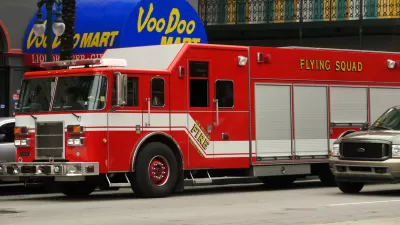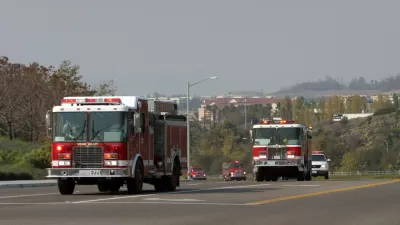When they're not extinguishing actual flames, fire trucks can seem comically over-sized on city streets. Replacing portions of the fleet with smaller response vehicles might save money without sacrificing capability.

One can imagine the frustration of first responders as they maneuver bulky vehicles through tight city streets. "It's no wonder firefighters in places like San Francisco, where the government has been pushing to improve safety by narrowing streets, call for the wider roads."
But maybe fire departments should adapt to streets. After all, the equipment aboard large fire engines is only necessary during a small minority of calls. Linda Poon writes, "Fighting actual fire makes up only a small portion of what firefighters do. Of the 31.9 million calls routed to all U.S. fire departments in 2013, only 1.2 million (or about 4 percent) were fire-related, according to the latest data from the National Fire Protection Association."
While it goes without saying that departments shouldn't impair their firefighting capabilities, smaller vehicles could respond effectively to most calls. "Some places, like Beaufort County in South Carolina, have opted for smaller 'all purpose response' vehicles. In 2010, its fire department had to replace three fire trucks, which would have cost them $1.4 million total. Instead the department ended up buying one new fire truck and replacing the other two with all-purpose cars the size of a pickup truck, paying just $675,000."
FULL STORY: It’s Time to Redesign the Big Old Red Fire Truck

Planetizen Federal Action Tracker
A weekly monitor of how Trump’s orders and actions are impacting planners and planning in America.

Restaurant Patios Were a Pandemic Win — Why Were They so Hard to Keep?
Social distancing requirements and changes in travel patterns prompted cities to pilot new uses for street and sidewalk space. Then it got complicated.

Map: Where Senate Republicans Want to Sell Your Public Lands
For public land advocates, the Senate Republicans’ proposal to sell millions of acres of public land in the West is “the biggest fight of their careers.”

Maui's Vacation Rental Debate Turns Ugly
Verbal attacks, misinformation campaigns and fistfights plague a high-stakes debate to convert thousands of vacation rentals into long-term housing.

San Francisco Suspends Traffic Calming Amidst Record Deaths
Citing “a challenging fiscal landscape,” the city will cease the program on the heels of 42 traffic deaths, including 24 pedestrians.

California Homeless Arrests, Citations Spike After Ruling
An investigation reveals that anti-homeless actions increased up to 500% after Grants Pass v. Johnson — even in cities claiming no policy change.
Urban Design for Planners 1: Software Tools
This six-course series explores essential urban design concepts using open source software and equips planners with the tools they need to participate fully in the urban design process.
Planning for Universal Design
Learn the tools for implementing Universal Design in planning regulations.
Heyer Gruel & Associates PA
JM Goldson LLC
Custer County Colorado
City of Camden Redevelopment Agency
City of Astoria
Transportation Research & Education Center (TREC) at Portland State University
Camden Redevelopment Agency
City of Claremont
Municipality of Princeton (NJ)





























